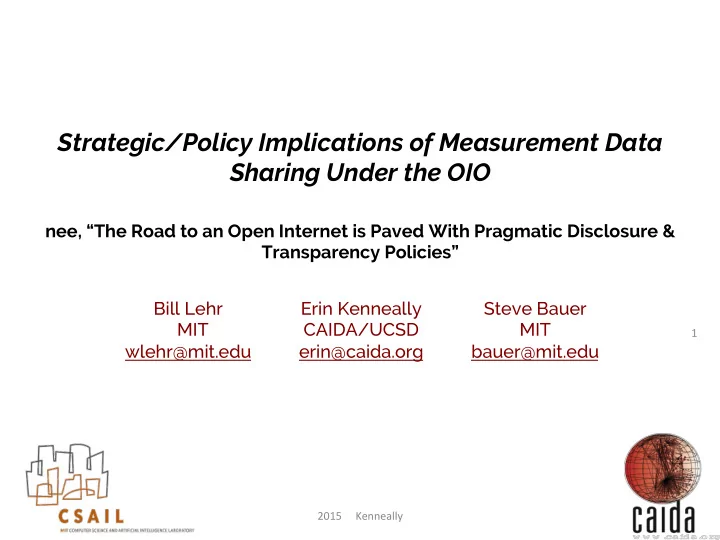

Strategic/Policy Implications of Measurement Data Sharing Under the OIO nee, “The Road to an Open Internet is Paved With Pragmatic Disclosure & Transparency Policies” Bill Lehr Erin Kenneally Steve Bauer MIT CAIDA/UCSD MIT 1 wlehr@mit.edu erin@caida.org bauer@mit.edu 2015 Kenneally
(2) Catalyst- Broadband Network Management Policies OIO D&T provisions play central role: ‘10 OIO – struck down, except for • D&T. Court recognized authority of FCC to issue such rules (all else potential wobblers) Includes : info disclosure obligations, performance measurement and • reporting platforms and practices, & processes for enabling multi- stakeholder participation in decision-making – Interpretation & implementation challenges – Induce intervention tools Range of D&T intervention tools: • – FCC orders and consent decrees – transparency & market research reports 2 – consumer complaints – Emergent capabilities: edge measurement tools ( net.info) , adapt models such as the Key Facts Indicator, ISP Censorship Transparency Reports, FCC NORS reporting 2015 Kenneally
(2) Catalyst- D&T Policies • 2015 OIO hybrid nature = source of authority + seeds of dispute re: info sharing – Principles: fl ex, universality, discretion v. application ambiguity, outcome uncertainty, ex-post remediation – Rules: ex-ante compliance speci fi city, certainty v. rigid decisions, less adaptable to evolving markets & tech Provides raw materials for D&T policies, NOT a blueprint for how applied to the • myriad network management scenarios and considerations Bright Line • – ISP Transparency of Performance, Practices, Terms – Disclosure process for Safe Harbor compliance – No tra ffi c blocking, throttling, or paid prioritization of lawful content, applications, services, or devices for BB access 3 Light Touch • – General Conduct Standard prohibits practices that unreasonably interfere with or disadvantage Consumers or Edge Providers; – Reasonable Network Management exception *BOTH* have decision, application and evaluation gray zones that warrant • intervention tools to address ambiguous and emergent interpretations . 2015 Kenneally
(2) Catalyst- D&T Policies E.g., Fading bright lines • – OIO requires speci fi c and detailed performance disclosures for users and edge providers (actual speed, latency, packet loss) – Performance metrics are far from standardized or settled – OIO does not indicate HOW loss should be measured or THAT di ff loss measurement methods yield di ff answers E.g, Internet tra ffi c exchange not-so-forbearance • – OIO explicitly forbears application interconnection, BUT FCC retains discretionary authority to govern interconnection via prohibition on unjust and unreasonable practices standard (caseXcase) 4 – QoS degradation: owing to users w/ Gpbs packet binging OR ISP nudging for surcharge/higher tier? – Is throttling protected IA/RNM or discoverable arti fi cial congestion? 2015 Kenneally
(3) Coordinator Tool for D&T Interventions Visual model to conceptually : (1) ✓ Compare interventions/tools according to a diversity of questions raised by D&T policies (descriptive) (2) ✗ Evaluate how multiple tools might address OIO objectives (need metrics for openness, innovation, investment) (prescriptive) 5 2015 Kenneally
(3) Coordinator Tool for D&T Interventions • Need multiple D&T to address knowledge gaps – Various sources of BB mgmt information – value of existing sources – impact on stakeholders – how to improve info asymmetries (correct or fi nd new sources), – how to integrate and share the information – what intervention strategies e ff ectively protect Internet openness, promote innovation and investment. Little consensus on best-practices for BB net management • – Are tra ffi c level metrics to individual subscribers >/< e ff ective than collective learning disclosure strategies? 6 – What’s the relative e ff ectiveness for consumer protection between disclosure to regulators and disclosures to the public or 3 rd parties? – What is a successful strategy for measuring congestion? Ultimate issue: whether stakeholders have the info they need and • trust in provenance; no one-size- fi ts-all approach given the 5 D&T Policies and application discretion 2015 Kenneally
(3) D&T Interventions- Transparency Reports • Measuring Broadband America (MBA) – Participating ISPs eligible for safe harbor compliance with the OIO transparency requirements – D&T pro fi le : tra ffi c level data and event level measurements (WHAT-axis); primarily targeted for the FCC and 3 rd party (WHO- axis); results in periodic (delayed) reporting of results (WHEN-axis) – What it accomplishes : • (a) speci fi city meets Safe Harbor and reduces regulatory uncertainty for ISPs • (b) network e ff ects and accountability among ISPs, may 7 enhance data quality, metrics consistency and reporting standards • (c) better informed technique comparison (apples::apples) 2015 Kenneally
(4) Applying Coordinator to Use Contexts – Packet Loss • Spoiler Alert: : speci fi c edge measurement intervention is more e ff ective than a type of transparency report in disclosing certain required performance metrics and practices (loss, security) because of the level of detail, timeliness and targeted recipient. (A) MBA • – D&T pro fi le : What: tra ffi c-event; Who: FCC-3 rd pty; When: delayed – De fi ciencies (a) di ff erent measurement methods for loss may give very di ff erent answers (“loss” as UDP/ICMP/VOIP packet; down/upload speed and latency under load) 8 (b) loss depend on other network performance (how TCP is managed, which ISP don’t control) (c) released 1x/yr for 1mo period (d) not just active msrmt, router interface IMAGE à 2015 Kenneally
(4) Applying Coordinator to Use Contexts- Packet Loss Comparable routes loss rates from router interface v. ac4ve probes 9 h3p://pages.cs.wisc.edu/~pb/intcomp_final.pdf 2015 Kenneally
Recommend
More recommend